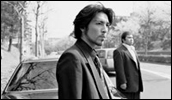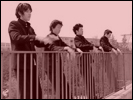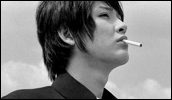Blue Spring
- Year
- 2001
- Original title
- Aoi Haru
- Japanese title
- 青い春
- Director
- Cast
- Running time
- 83 minutes
- Published
- 9 April 2002



by Tom Mes
Based on a manga by Taiyo Matsumoto, Toshiaki Toyoda's Blue Spring is a story about high school anarchy in the long, bruised-and-battered tradition of Be-Bop Highschool (1985 - Hiroyuki Nasu) and Fudoh: The New Generation (Gokudo Sengokushi: Fudoh, 1996 - Takashi Miike). In a school surrounded by misleadingly picturesque cherry trees in full bloom, it's the students who set the rules while uncooperative teachers are dangled from windows.
In this power structure, the leader is decided by a peculiar game of dare: hanging from the rooftop fence, he who can clap his hands the highest number of times without plummeting to his death is king. Violent assaults on the throne are punished with a severe bruising or in worse cases with a kitchen knife in the gut. The desolate concrete hallways of the building are covered floor to ceiling in black graffiti, which acquires a new coat each time another student comes to power. The hierarchy, the violent power games and the general lazing about seem to be these kids' only raisons d'etre. Family life is never seen, education and career prospects are non-existent.
The only option outside school seems to be joining the yakuza, who regularly patrol the streets around the school grounds in their white limos, looking for new recruits. Recruits who will be adopted in to a system of hierarchy they know all too well. Just when we think the school seems like a training ground for organised crime, we realize how many similarities there are between gang life, school life and corporate life. With that, it's clear that Toyoda's intentions are less about commenting on a failed educational system or lawless youth, than about showing the universal nature of our need to rule and regulate. By using children as his subjects, it becomes poignantly clear that hierarchies, violence and a craving for power are human traits which are not specific to any single isolated part of society. Toyoda's story takes a step beyond the depictions of violent, disaffected youth seen in so many Japanese films of recent years (Battle Royale, Harmful Insect, Hysteric and his own film Pornostar to name but a few), and shows that if the young were to seize power, the result may look like anarchy, but in fact would be a society with the same structures as the one they have just overthrown.
Director Toshiaki Toyoda is a former Shogi (Japanese chess) prodigy, a sport that commanded most of his childhood years. In his late teens, realizing he lacked the determination to make it as a professional, he turned his back on the sport entirely and went though a period of adolescent rebellion. After seeing Junji Sakamoto's film Knock Out (Dotsuitarunen, 1989), he realized cinema was his calling and moved from his native Osaka to Tokyo with two electric guitars and 20,000 yen he'd borrowed from his parents. In 1991 he made his debut as a scriptwriter and assistant director with Checkmate (Ote) for that same Junji Sakamoto, an event that occurred after Toyoda sent the director a letter asking if he could work on Sakamoto's films. Toyoda made his directorial debut in 1998 with the aforementioned Pornostar, a portrait of youth on a rampage in Tokyo's Shibuya district, which he followed up with the feature-length documentary Unchain, about a boxer who has never won a bout in his entire career.
As noted, Blue Spring is in some ways a follow-up to his debut film. Whereas Pornostar was criticized by some for relying too much on posture and coolness, Blue Spring adds more dimension to its portrayal of a generation of 'don't-fuck-with-me' kids, both in terms of surface style and of characterisation. There is posturing here, certainly, but this film has attitude. Director Toyoda uses familiar methods like slow motion and a blazing rock score to reinforce the nature of his characters, yet Blue Spring's is not the artificially imposed wannabe-toughness of a hiphop video, nor does it depend on the manga excess of Miike's Fudoh. Toyoda understands that he is using tools, means to get to an end. In Blue Spring's guitar-driven slow motion sequences stories are told, characters are established and relationships are made clear. This certainly isn't a case of style over substance, this is a case of a filmmaker knowing his craft.
Whether or not those methods will be successful in the final results does however depend on one crucial thing: the cast. In a film like Blue Spring, if the actors lack the ability and the presence to portray the no-holds-barred roughness of the characters (plus their humanity, to make it just that little bit more difficult), all the director's trickeries won't save it from coming across as a film that tries too hard to be tough. But despite their young age, these kids are completely convincing, with Ryuhei Matsuda's magnetic central performance in front. The son of the great Yusaku Matsuda shows a tremendous growth from his eye-catching breakthrough role in Nagisa Oshima's Gohatto, both as an actor and as a man. In the two years that separate both films, he has become less the androgynous curiosity piece and has instead gained a boyish masculinity, as well as a seeming boost of confidence. By sheer charisma and presence, and without showing the slightest effort, he commands every shot he's in. Matsuda is the undisputed star of this show and his performance in Blue Spring signals the arrival of a movie star.
Although Blue Spring is filled with fights, deaths and murder, Toyoda keeps the violence subtly but resolutely off-screen, proving quite succinctly that less is more. If the film feels like a barrage of blood-drenched confrontations, it's because the director does such a good job at implying them. Blue Spring is not a violent film for the sake of being a violent film; its characters are too well rounded, its touches of dreamlike beauty too poetic for it to be dismissed as such. And its director is far too good a filmmaker to be suckered into making a pretentious bloodbath.